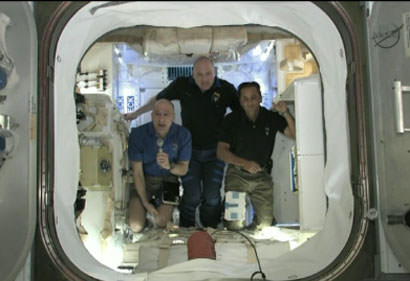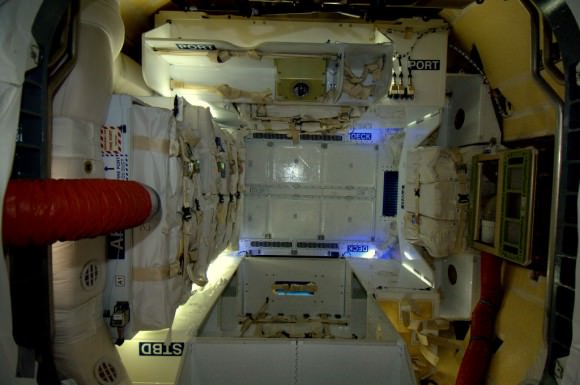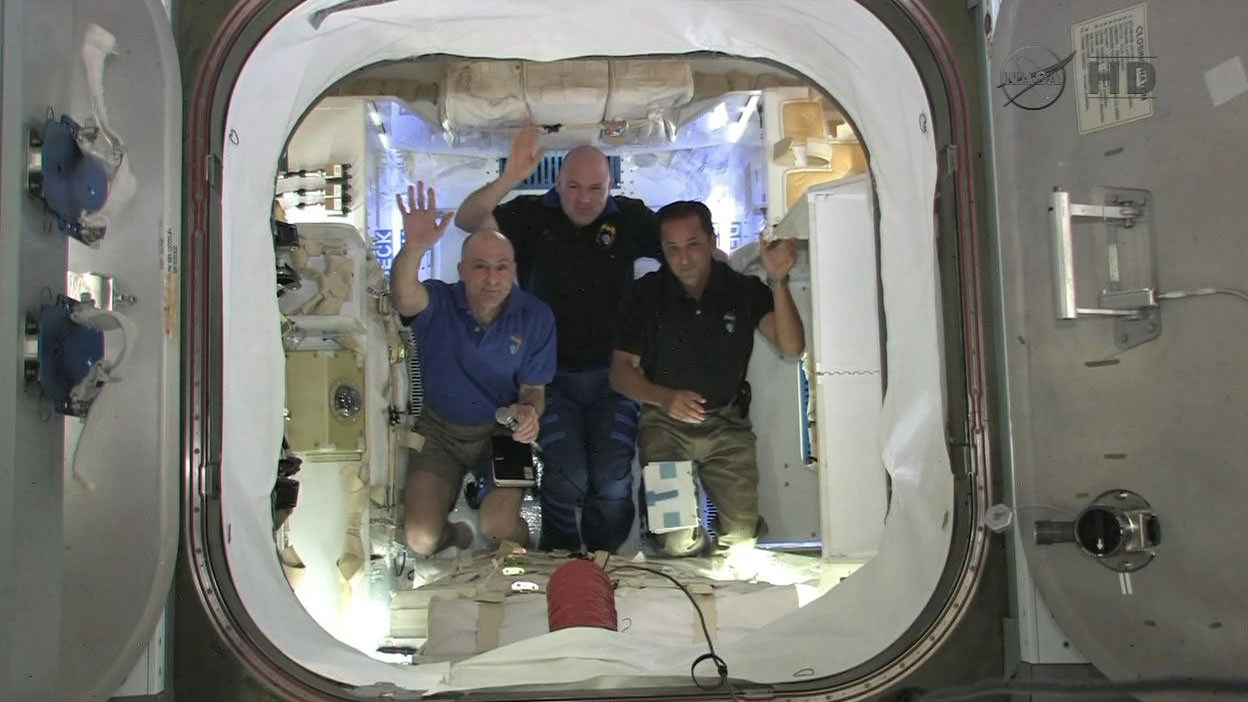[/caption]
Just how many astronauts can you cram inside a Dragon ? – think Volkswagen Beetle!
Well at least 6 human space flyers can easily fit inside a SpaceX Dragon vehicle, said NASA Astronaut Don Pettit from aboard the ISS during a Q & A session with reporters on Saturday, May 26. The discussion with the media took place only hours after Pettit’s history making hatch opening to the first private space capsule ever to dock at the International Space Station (ISS).
“We’ve already had all 6 people in here for a brief period,” Pettit told Universe Today during the media session on Saturday, soon after the hatch opening. “We haven’t taken any pictures of all 6 [together] yet.”

The three current station residents who played the key roles in the milestone events of grappling the Dragon cargo resupply craft with the station’s robotic arm and parking it at an open port on the Harmony Node 2 module on Friday, May 25, spoke to reporters while floating inside Dragon for about 20 minutes all told – including Pettit, ESA Astronaut Andre Kuipers and newly arrived fellow NASA astronaut Joe Acaba.
“There’s not enough room in here to hold a barn dance, but for transportation of crew up and down through Earth’s atmosphere and into space, which is a rather short period of time, there’s plenty of room in here for the envisioned crews,” Pettit told me while soaring some 400 kilometers (250 miles) above Earth.
Dragon is the world’s first commercial spacecraft to attach to the ISS and was built by SpaceX Corporation, founded in 2002 by CEO and Chief Designer Elon Musk.
All three crew members seemed quite pleased with the Dragon’s layout and quite willing to fly aboard a human rated version in the future. SpaceX is designing Dragon to be capable of carrying 7 passengers in the crew configuration – and it looked spacious to me during the media briefing.

Caption and Photo Credit: Andre Kuipers/ESA/NASA
“I spent quite a bit of time poking around in here this morning, just looking at the engineering and the layout, and I’m very pleased,” said Pettit. “It looks like it carries about as much cargo as I could put in my pickup truck. And it’s roomier than a Soyuz, so flying up in a human-rated Dragon is not going to be an issue.”
The gumdrop shaped Dragon capsule is 4.4 meters (14.4 ft) tall, and 3.66 m (12 ft) in diameter. It has an internal pressurized volume of about 350 cubic feet
On this first NASA sponsored test flight to rendezvous and dock at the ISS it was packed with 460 kilograms (1014 lbs) of non-critical cargo including 306 kg (674 lbs) of food and crew provisions; 21 kg (46 lbs) of science experiment; 123 kg (271 lbs) prepositioned cargo bags to be used for future flights; and 10 kg (22 lbs) of assorted computer supplies and a laptop.
The crew starts unloading Dragon today. It will remain berthed at the million pound orbiting outpost for about 6 days until it is detached on May 31 for a return trip to Earth and splashdown and retrieval in the Pacific Ocean a few hundred km (mi) off the coast of California.
The Dragon launched flawlessly atop a SpaceX built Falcon 9 booster on May 22 from Pad 40 at Cape Canaveral Air Force Station, Florida.
Since the forced retirement of NASA’s Space Shuttle fleet in July 2011 and for at least the next 3 to 5 years, the only way U.S. astronauts can reach the ISS is aboard ferry flights on the cramped three person Russian Soyuz capsule at a cost of some $60 million per seat to U.S. taxpayers.
SpaceX is one of four private companies receiving NASA funding under the Commercial Crew and Cargo Program and seeking to develop commercial “space taxis” to low Earth orbit.
A human-rated Dragon is one of the vehicles engaged in the on-going competition and vying for a NASA contract. But the first crewed flight to restore US human spaceflight capability has been delayed by years because of repeated slashes to NASA’s budget by the US Congress.
NASA now estimates that the first space taxi – possibly the SpaceX Dragon – won’t fly until about 2017.


There gap in US natively sourced Human Space Flight (thanks Dr Griffin, US Congress) maybe many years, but the gap in US up-cargo and down-cargo capability was closed in 11 months.
Just guessing here, but it should be technically possible for Dragon to return crew sooner rather than later, as you don’t need a Launch Abort System (under development) for a crew return trip.
Thanks for pointing to the video clips UT.
In that case, Dragon could be suitable as a ‘lifeboat’ if access to the two Soyuz are compromised.
it doesn`t have what it takes to return safely, it will burn on reentry. What i don`t understand is why they don`t keep it linked to the station as to all the other modules that came by. What`s the hurt on having bigger space for air and walks? I know they have to dump the waste and debris , but it could be found a less expensive way.
?
The Dragon has a better heat shield than the Apollo had, which did high velocity atmospheric reentry:
“The Dragon is a reusable spacecraft … utilizes a PICA-X heat shield – based on a proprietary variant of NASA’s phenolic impregnated carbon ablator (PICA) material – designed to protect the capsule during Earth atmospheric reentry, even at high return velocities from Lunar and Martian destinations.”
The first Dragon returned “almost as new”, and SpaceX plans to use the COTS crafts for other launches. (NASA has ordered new crafts servicing them, but SpaceX believes the heat shields are good for 10 or more LEO reentries.)
The crafts aren’t used for extending the station for the same reason you don’t use your car to extend your house. They have limited ventilation and power, they have limited access (see the first image), they have limited lifetime of ~ 2 years and most importantly they don’t have the same meteor shields. Those are required, since the ISS lifetime is ~ 30 years before an impactor trashes a module.* **
———-
* Maybe the shields can be retrofitted.
** In which case it will be possible to reconfigure the ISS in many cases and keep the station indefinitely. But that isn’t the plan as of yet.
“What i don`t understand is why they don`t keep it linked to the station as to all the other modules that came by. ”
The answer to that is mostly the same as uninformed suggestions to leave a Shuttle orbiter connected indefinitely to ISS:
Why would you tie up a docking hatch with an object that’s not meant to be in space indefinitely?
It’s like backing up a truck trailer to a loading dock, then wanting to leave it there for ‘more room.’ It’s not designed to be a room, and you’ve lost use of that loading dock.
And as noted by Torbjörn Larsson, Dragon is intended for re-entry, and has already demonstrated that capacity. You may be confusing it with Progress, ATV and H-II, which *were* expendable…and were still not designed to be station modules, nor would they have left the docking ports free for further use.
Not all in-space pressurized volume is equal …
“Just guessing here, but it should be technically possible for Dragon to return crew sooner rather than later, as you don’t need a Launch Abort System (under development) for a crew return trip.”
Although if they successfully get to the point that Dragon can do powered landings after re-entry, those same rockets will be present, anyway. You’ll want to recover even unmanned Dragons from a launch abort, because they’re meant to ultimately be re-used, and so are a valuable investment. Users of the free-flying ‘DragonLab’ versions would appreciate getting their payloads back, as well.
‘Unmanned’ no longer means it’s necessary to allow every part of the launch be written off after an accident.
Thanks to our leaderships foresight and visionary planning America sits in the back of the bus for spaceflight. Mediocre America . . .
As if this Dragon test flight didn’t tend to demonstrate otherwise, America is in ‘the back of the bus’ with respect to…whom?
Who do you think *is* actually doing ‘visionary and foresighted’ things at the moment?
Names and accomplishments, please.
“The Dragon launched flawlessly atop a SpaceX built Falcon 9 booster on May 19 from Pad 40 at Cape Canaveral Air Force Station, Florida.”
Isn’t it May 22?
my friend’s aunt made $17398 the previous week. she is making income on the internet and bought a $578000 house. All she did was get lucky and try the steps written on this website===>> ?????? startworkat.blogspot.com
I can’t understand, if S/shuttles were built on state plants or with assistants of privet contractors.
If so, than the case is just the matter of responsibility?